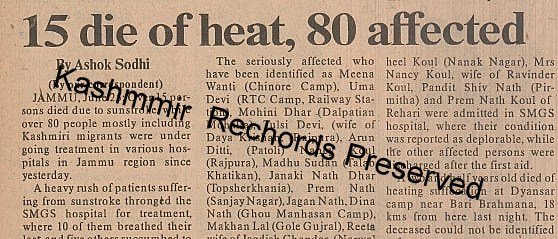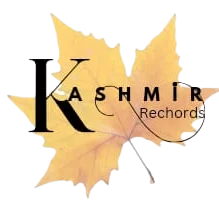(By: K R Ishan)
As North India swelters under a relentless heat wave every summer, memories flood back for the Kashmiri Pandit community. This scorching heat evokes the harrowing summer of 1990 when thousands of Pandits were forced to leave their idyllic homeland of Kashmir—famous for its cool climate, verdant landscapes and serene brooks—and face the blistering plains of India. It was a transition from paradise to an inferno, a shift they were woefully unprepared for.
Fleeing Violence for Unfamiliar Terrains
In January 1990, the rise of militancy in Kashmir reached a terrifying peak, compelling an exodus of Kashmiri Pandits. Fleeing the violence that claimed the lives of many in their community, they sought refuge in unfamiliar regions like Jammu and Delhi. These places, with their oppressive heat, were a stark contrast to the cool, gentle summers of their native land. For many Pandits, the concept of a heatwave or sunstroke was as alien as the scorching temperatures they were suddenly exposed to.
Over 120 Casualties Due to Sunstroke

The summer of 1990 became a season of nightmares for the displaced Pandits. Reports from May, June, and July that year, analyzed by Kashmir Records, reveal a grim picture: over 120 Kashmiri Pandits succumbed to sunstrokes during their first severe summer away from home. Their bodies, unaccustomed to such extreme heat, were unable to cope, and the inadequate living conditions exacerbated their plight.


Living in Makeshift Camps
Newspaper obituaries and headlines from that year tell a story of immense suffering. In makeshift camps set up in Jammu and Delhi, families lived in tattered tents with no proper sanitation or potable water. Dehydration and cholera became rampant as people were forced to drink contaminated water and consume stale food. The lack of basic amenities like fans, coolers, or refrigerators made survival even more arduous. Many women, who had never left their cool, green villages, found themselves standing in long lines for meager rations under the punishing sun, only to be overcome by heatstroke.

The Elderly and Vulnerable
Elderly men and women, who had thrived in the gentle climate of Kashmir, were now battling not just the trauma of displacement but also the unforgiving summer heat. They had been uprooted from a land where the concept of heat-related illnesses was virtually nonexistent and thrust into an environment that proved fatal for many. The authorities’ failure to provide adequate shelter and resources further deepened the tragedy.
Eyewitness Account
Journalist Dr. Rajesh Bhat, who then worked as a special correspondent for Jammu’s leading newspaper, Daily Excelsior, was one of the newsmen who documented and reported the plight of Kashmiri Pandits. As he covered the unfolding tragedy, besides other things, he witnessed firsthand the devastating effects of the heatwave on the displaced Pandits. “The suffering was unimaginable,” Dr. Bhat recalls. “I saw families who had never experienced such extreme temperatures struggling to survive in tents that offered little protection from the sun. The heat was relentless, and the lack of basic necessities made the situation even more dire. Reporting on the deaths from sunstroke was heart-wrenching. It wasn’t just the militants they were fleeing from; it was as if they had escaped one form of death only to face another.”

Alongside Dr. Bhat was photojournalist Ashok Sodhi, who dedicated his life to capturing the stark realities of the time. Late Ashok Sodhi, a respected figure in journalism, traversed the camps with Dr. Bhat, documenting the harsh conditions and human suffering through his lens. His photographs brought the plight of the Kashmiri Pandits to the forefront, providing a visual testimony that words alone could not convey. “Ashok’s photos told stories that needed to be seen and believed,” Dr. Bhat reminisces. “He had an eye for capturing the raw emotion and desperation in those camps. His work was instrumental in raising awareness and empathy for the displaced community.”

A Chilling Chapter in History
The summer of 1990 remains a chilling chapter in the history of the Kashmiri Pandit community. As temperatures soar today, the survivors and their descendants are reminded of that devastating time. It is a poignant reminder of their resilience and the harsh realities they faced, a story of human endurance against both man-made and natural adversities. The efforts of individuals like Dr. Rajesh Bhat and Ashok Sodhi ensured that the world did not turn a blind eye to their suffering, preserving the legacy of their struggle for future generations.


